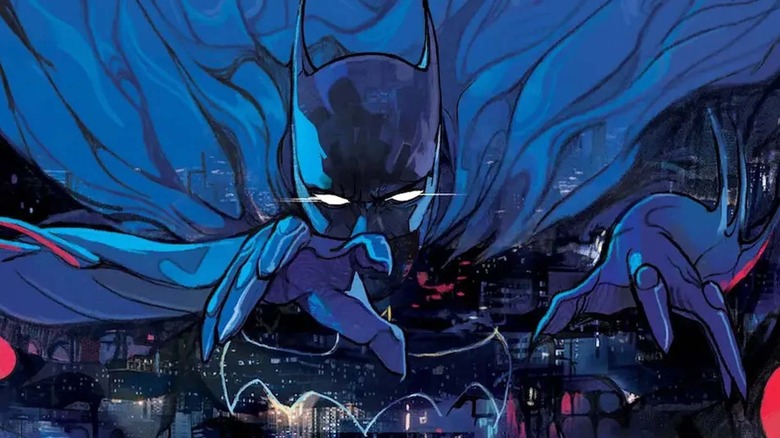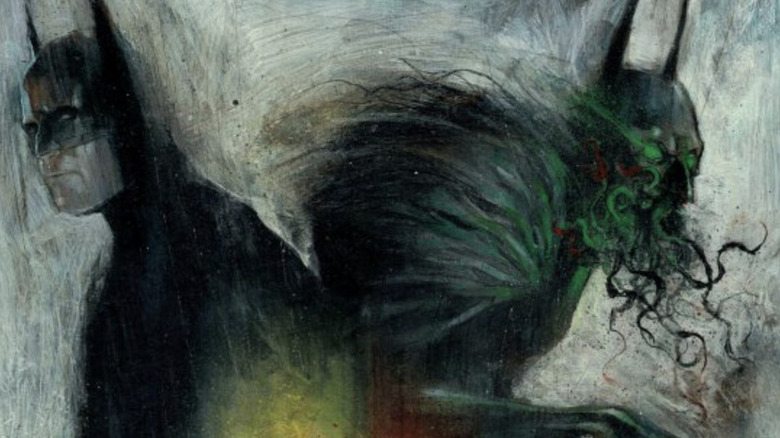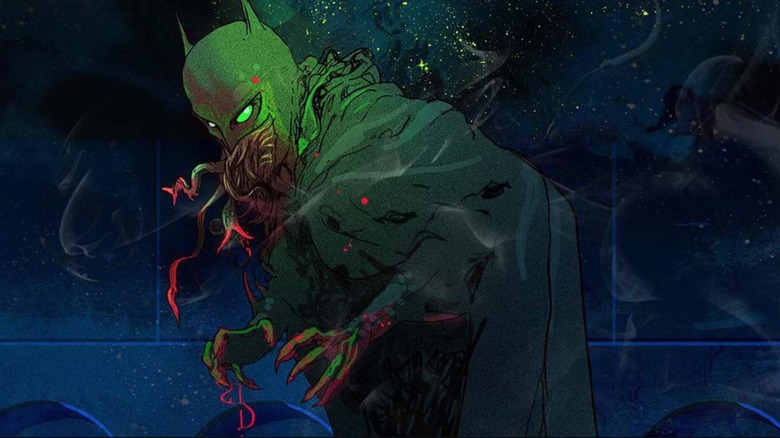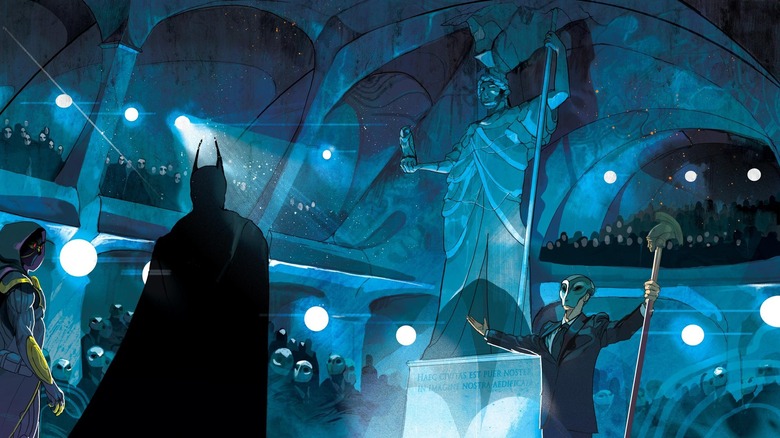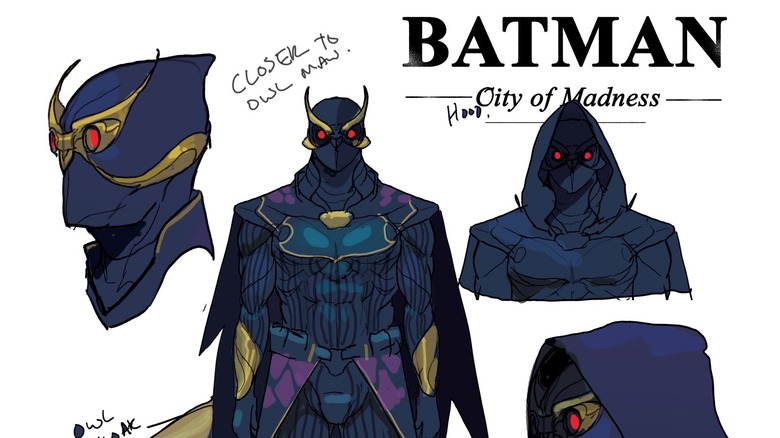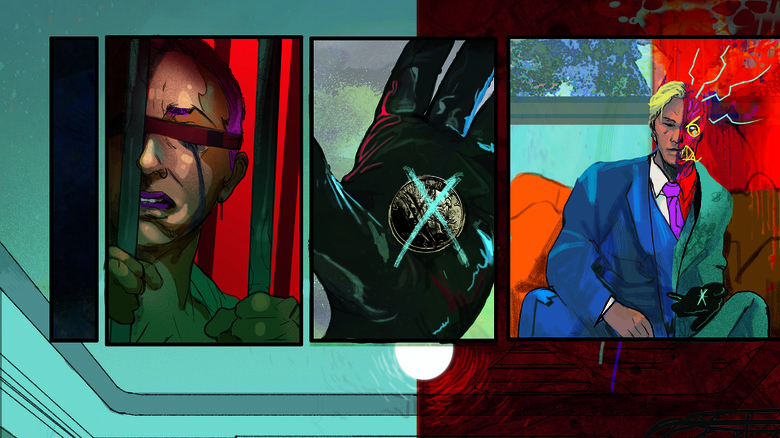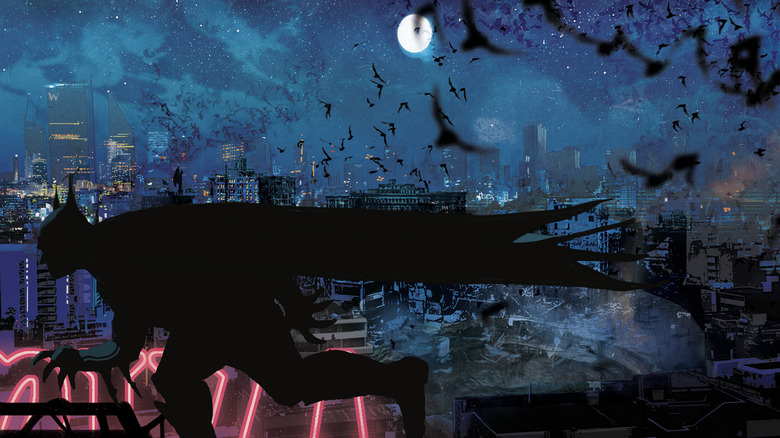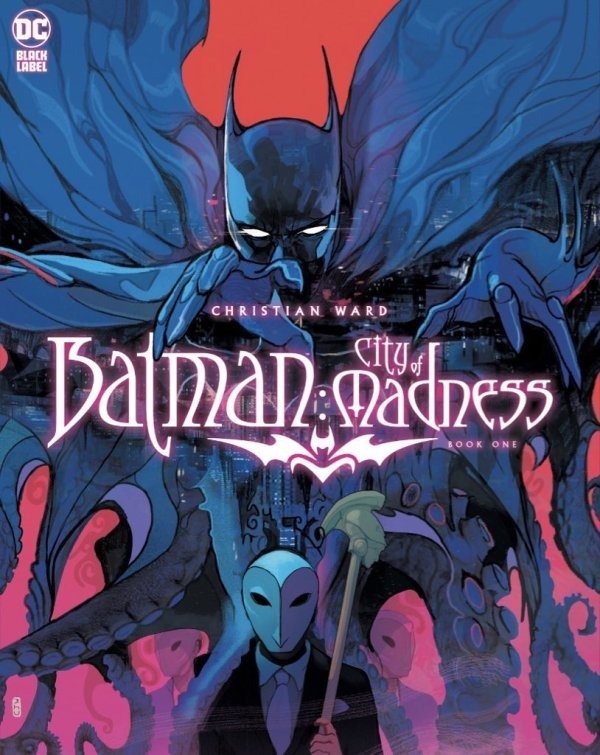Batman Goes Cosmic Horror In Christian Ward's Batman: City Of Madness - Exclusive Interview
Contains spoilers for "Batman: City of Madness" by Christian Ward
DC Comics is shining a light on a new, dark part of Gotham City in "Batman: City of Madness," where the upcoming three-issue miniseries will introduce Gotham Below and the Batman Below — twisted mirror versions of the Dark Knight's home. The comic from writer and artist Christian Ward will feature Batman, the Court of Owls, and several redesigned villains as they deal with the Batman Below emerging from Gotham Below as he tries to put his horrifying imprint on Gotham City after being kept contained for decades.
We got the chance to speak with Ward about "Batman: City of Madness," what inspired the book, how it explores a new side of Gotham, what it was like for him to put his stamp on several iconic characters while introducing a new version of Batman, and what twisted things he has planned for the story.
How the comic began and became a full-fledged story
You've mentioned this project was years in the making. When was the first concept conceived? How'd it come to fruition, and how does the story take Batman in this new direction?
It's weird. This thing has been growing in me like a dark seed since I read "Batman: Arkham Asylum" when I was 13. I've been in love with this slightly stranger world that Batman exists in. When I read that book — and even now when I go back — there's something very strange and dangerous about it because of what's happening around the peripheral edges. This idea of something old and dark ... Even though there's nothing explicitly cosmic horror about it, it feels very cosmic horror when I read it. I've always wanted to do a homage to that book, a thank you, a tribute. This idea, or at least a part of it, a rough version of it, has been in my head for at least 10 years, if not longer.
The character that's in the book called the Batman Below — who's this version of Batman that has come out of the abyss — the first time I drew him was in 2021, with these Cthulhu-like tentacles coming out of his mouth. I posted it on Twitter, and it exploded. It was funny because, at the time, a lot of my tweets didn't have huge results. If I posted something, I'd get maybe 20 or 30 likes, and then I posted that, and it was 2000 likes.
Obviously, you post Batman and it has a greater reach, and a lot of the creator's own work, I was working on at the time. But I got this sense that, "Hang on, this is something special here." I would post it again and I had the same response again. I was like, "This is not fluke. People [are] interested in this character and this cosmic horror Batman that I'm proposing." Then I posted it again and again — it blew up.
The third time I posted it was toward the end of 2022 when I was finished up working on "Aquaman: Andromeda" with Ram V at DC Black Label. My editor at the time — Chris Conroy, who's the group editor — reached out to me and said, "What is this Batman that you keep going on about?" He said, very simply, "Is there a story?" And because this thing had been growing since I read "Arkham Asylum" when I was 13, there was a pretty fully formed story. Within an hour, I was able to put it down onto pitch documents, send it to DC, send it to Chris, and it was exciting to ... It was greenlit within a week or so. Then, from November onwards, I've been working on "Batman: City of Madness."
Creating a new version of Batman
"City of Madness" takes a deep dive into what lurks below Gotham City. What was it like to explore a new facet of Gotham that is your own twist on it?
Well, one, I wanted to come up with something that I felt like I could do justice to visually. When I did my previous book, "Blood Stained Teeth" at Image Comics with Patric Reynolds, Patric was the best choice of that artist because it was a very grounded story despite the vampires. This, I wanted it to be [that] only I could draw this book. With that in mind, I wanted to move as far away from reality as the remit of Batman would allow me to. The cosmic horror gave birth to this idea of this mirror version of Gotham — there was essentially a nightmare version. Because it was a nightmare version, it could be intangible; the edges could be soft, it could be otherworldly, it could feel nightmare-ish and strange and impossible. It was a natural choice to explore.
It was almost like "Alice in Wonderland," because there are always these parallels between "Batman" and "Alice in Wonderland," and I like the idea that the city underneath was almost like Bruce's Wonderland, this place where everything was topsy-turvy. It didn't make sense. It was the opposite in many ways. Normal reality does not apply. I was using that in a very thematic way of exploring the character of Batman and the themes of "Batman" in a way that I could do that visually through the city.
What can you say about Batman, the Batman Below, and Gotham Below? The design is frightening.
Oh, he is. He's terrifying because he has to be. That comes from the idea of ... I always go back to "Batman: Mask of the Phantasm" and that conversation Alfred has with Bruce when they're in the Batcave, and they're having this discussion about him being worried about Bruce, that he walks this line. He looks into the abyss, and he worries about what would happen if he falls in.
That's a common recurring theme in "Batman." You look into the abyss, and the abyss looks back. What I'm proposing in this story is Batman looks into the abyss, and Batman Below is the Batman that looks back. He has to be hideous. He's monstrous. As we find out, the hook of the book — the mystery of the book — is who is Batman Below, and how does he connect to Bruce, the mirror version? What has led him to be this monstrous version of the same character?
Obviously, the tentacles are a callback to Cthulhu and Lovecraft and the cosmic horror that I love, that I wanted to bring into this, and using that very iconic unhuman mole that is associated with cosmic horror. Gotham Below is his den. It is the place where monsters live, the place where there are dark things that shouldn't exist that do exist.
Why the Court of Owls is perfect for City of Madness
Despite being introduced relatively recently, the Court of Owls has become an integral part of Gotham's history. What makes them so frightening, and what was it like to play in the sandbox and introduce them as the guardians of the door to the Gotham Below?
I don't think that element is new for me. Their creators, Scott Snyder and Greg Capullo — they definitely created those characters as having ownership of Gotham that was much older than Batman's. That's where the tension in "Court of Owls" comes from. I like the idea that perhaps — even though they're bad guys and their motives aren't always pure — I like the idea that somewhere, there is this element of them [wanting] to protect the city, even if it's for motives that are about lining their pockets. They want to protect the city. There were interesting parallels and ways in which they and Batman would connect with that.
They're so creepy in the way that Greg designed them with this blank face, and I say that as an '80s U.K. child who grew up with the Cybermen from "Doctor Who." There's something about the blank face that is scary. They were very creepy in "Court of Owls," but it was easy to push them a little bit to the left and have them in cosmic horror. They fit so beautifully within that world that they were the natural choice.
Cosmic horror is science fiction that looks back rather than science fiction that looks forward, and that's where the horror comes from — because it's already happened, it's already the end of the world, it's already a disaster, and we're already in it. It's always about that, the ancient. When you're looking at Gotham and you want something that's old and ancient, it has to be the Court of Owls.
The Court of Owls' role in the book
How does Batman's relationship with Gotham and the Court play a role in the story? Because for once, he's finding himself almost being forced to work alongside these sinister, shadowy figures.
I wanted to look at Bruce's elegance and the idea that he knows all; he knows what to do. He has a very clear idea of, "This is the way to do things, and I'm right, and I've been doing this long enough that it's the way it's done." I wanted to challenge that arrogance and have him come to the realization that perhaps he isn't always right, and that plays a bigger role in the story in regards to how he feels toward Robin, Nightwing, Batgirl, and all the other Bat-Family. Really, it's about him realizing that his way isn't always the right way. He's forced to have this uneasy alliance with the Court because what is happening is so far out of his remit that he's forced to align himself with them. Of the journey that he's going to make over the three issues, those ideas of aggregate are what he's going to challenge and how he's going to grow and change.
That's always the challenge when you do a character like Batman. Most of the stuff that I've got, all the stuff I've written, has been quite around — so I get to decide, "How is this character going to grow? How is this character going to change? What is this situation going to do to them?" When you're working with a character that you haven't created that has literal decades and decades and decades of growth, and everything that could possibly happen [has] happened to them, you have to find a way ... That character can't change completely. It has to still be true to who that character is. It is finding the way that, "Okay, that's what he's going to learn. That's how he's going to change" — without breaking him, without being disrespectful to who he is and why that character works.
For me, Batman's very much Hamlet, a character who's trying to get revenge and trying to make his trauma heal through acts of violence. He's been forced into this world essentially by ghosts, but he's pulling other people in with him. His journey on this will be about realizing his effect on other people and on Gotham itself.
You mentioned before that this is a pseudo-sequel to "Batman: Arkham Asylum," in a way. Were there any non-comics that inspired this book? You mentioned Lovecraft before.
Lovecraft, "Alice in Wonderland" — those are the two big ones.
There's a little bit of the "Pied Piper" in there. There are a lot of old stories and old fairy tales that I'm trying to use, stories that have always been used to scare children at bedtime. It's, again, why cosmic horror is different from straight sci-fi, because it feels old. It's this strange oxymoron of something we don't stand from, that's alien and shouldn't exist within our realm but does. A lot of the stuff that I've been mining from is very old fairy tales and folklore, cosmic horror, "Alice in Wonderland," "Pied Piper," all that sort of stuff.
Redesigning iconic characters in his style
This book sees a lot of new versions of fan-favorite characters, both above and below. Was it daunting to put your own spin on these characters, or was it like, "Okay, now I can finally do my own thing"?
It's fun. Obviously, this whole book is built on the shoulders of giants that have come before me. They all exist because someone else has done the groundwork; you want to do something new [that] doesn't negate what someone else has done. I love all the takes that have come before me. I still love them. The "Batman" books are the ones I read the most, and I love this character in the same way that all the other writers and artists love the character. But it's fun to put your spin on there because I might not get this chance again to do another "Batman" story. I hope I do, but I may not. So I've approached this book with the idea that I am going to put 100% in — everything is Christian Ward.
This feels far more like an indie book than it does a book owned by somebody else because I'm putting my heart and soul into it. I'm putting everything into the redesigns and thinking about characters and how they work, which characters fit in this world, which characters wouldn't fit in this world, [and] how I can have fun with the characters in a way that doesn't betray what I'm doing with the story. It's been great fun ...
For instance, in Issue 2, Flamingo's in it, who's always been a big favorite of mine, because I'm a big fan of [Grant] Morrison and [Frank] Quitely's "Batman and Robin" run. To be able to do that, to be able to put characters in that I love — sure, it's fan service, but that's why we are here, because we love these characters and we worship them. It's a huge honor to be in the position to be able to do that.
What made Black Label the perfect format for this book? You have a lot more freedom in what you can do, and the prestige format lends itself well to a book that leans heavily on a certain visual style.
I had such a great time working with the Black Label team on "Aquaman: Andromeda." It was brilliant. I had real fun. You are able to do things without any barriers. I was surprised because "Batman: City of Madness" goes to some crazy places, and there was no, "You can't do that, you need to soften that." The book that's going to be on the shelf is 100% the book that I had in mind. You can't do that anywhere. The only place you can do that is like an Image Comics book. Yet somehow, magically, I've been able to do that with "Batman." My God, it's amazing. I am having the biggest ball at the moment, having the time of my life working on this. It's amazing.
Are there more plans to do potential "Batman" books if this one finds the right audience? Do you have anything brewing?
I don't know. People like Sean Murphy started with one book, and now he's got the "White Knight" universe. Who knows? Maybe. We'll see what happens. The way I'm treating this is I'm putting everything into this. If it leads to more, I will be very happy to return to this version of Gotham and cook up something new. We'll have to wait and see.
Batman: City of Madness arrives in comic book stores later this year
Christian Ward is giving everything he has to make "Batman: City of Madness" his most special comic yet. For a writer and artist who has already given readers some great stories with "Aquaman: Andromeda" with Ram V, "Black Bolt" with Saladin Ahmed, "Blood Stained Teeth" with Patric Reynolds and Heather Moore, as well as "Invisible Kingdom" alongside G. Willow Wilson, his solo venture represents an exciting new take on Batman and Gotham City. Check out the cover by Ward for "Batman: City of Madness" #1, which arrives in comic book stores and online retailers on October 10. The three-issue miniseries is set to be a dark, can't-miss adventure for the Dark Knight.
"Buried deep beneath Gotham City there exists another Gotham. This Gotham Below is a living nightmare, populated by twisted mirrors of our Gotham's denizens, fueled by the fear and hatred flowing down from above. For decades, the doorway between the cities has been sealed and heavily guarded by the Court of Owls. But now the door swings wide, and the twisted version of the Dark Knight has escaped ... to trap and train a Robin of his own. Batman must form an uneasy alliance with the Court and its deadly allies to stop him — and to hold back the wave of twisted supervillains, nightmarish versions of his own nemeses, each one worse than the last, that's spilling into his streets!"
This interview has been edited for clarity.
